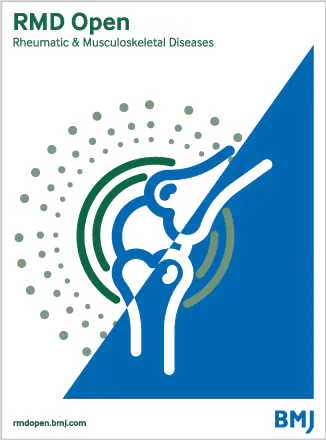临床缓解期类风湿性关节炎患者随访一年发现持续的动力多普勒超声检测滑膜炎预示着不良预后:SONORE 前瞻性纵向研究
IF 5.1
2区 医学
Q1 RHEUMATOLOGY
引用次数: 0
摘要
目的 (1) 评估随访 1 年的类风湿关节炎(RA)缓解期患者中超声波检查出的滑膜炎的进展情况 (2) 评估连续超声波检查预测 1 年后复发(R)或影像学进展(RP)的能力。方法 临床缓解期的 RA 患者(2010 年美国风湿病学会-欧洲风湿病学协会联盟标准)(28 个关节的疾病活动度评分(DAS28)0.6 或 DAS28-CRP>3.2 以及任何改变病情抗风湿药或糖皮质激素的治疗均定义为复发。采用单变量和多变量 Cox 回归分析评估 1 年后 R/RP 的相关因素。结果 115 名 RA 患者中,分别有 75 人(65.2%)、66 人、60 人、46 人和 29 人在基线和第 3、6、9 和 12 个月时检测到 PDUS。58(50.4%)名患者表现出持续的 PDUS。1 年后,22/85(25.9%)例患者复发,12(14.1%)例患者出现 RP。通过多变量分析,预测 1 年后 R/RP 的因素是持续的 PDUS(HR=2.98,P=0.014)和复发前就诊时 DAS28-CRP 水平的升高(HR=4.36,P=0.004)。结论 随访期间而非基线时持续存在的 PDUS 可预测 1 年后的不良预后,因此需要仔细监测。所有与研究相关的数据均包含在文章中或作为补充信息上传。本研究中生成和/或分析的数据集不对外公开。所有提供的数据都经过匿名处理,以尊重参与研究的患者的隐私,符合适用的法律法规。可向通讯作者索取数据。本文章由计算机程序翻译,如有差异,请以英文原文为准。
Persistence of power Doppler ultrasonography-detected synovitis over 1 year of follow-up predicts poor prognosis in rheumatoid arthritis in clinical remission: the SONORE prospective longitudinal study
Objectives (1) To assess the progression of ultrasonography-detected synovitis in a cohort of patients with rheumatoid arthritis (RA) in remission during 1 year of follow-up (2) to evaluate the ability of consecutive examinations of ultrasonography to predict relapse (R) or radiographic progression (RP) at 1 year. Methods Patients with RA (2010 American College of Rheumatology-European Alliance of Associations for Rheumatology criteria) in clinical remission (Disease Activity Score in 28 joints (DAS28)<2.6 without clinically active synovitis) were included. An independent investigator performed ultrasonography every 3 months for 1 year. Ultrasonography-detected synovitis was defined as power Doppler-positive ultrasonography synovitis (PDUS) grade ≥1 in at least one joint. PDUS at ≥2 consecutive visits during the follow-up defined persistent PDUS. An increase of ≥1 point in the modified total Sharp score defined RP. An increase in DAS28-C-reactive protein (CRP)>0.6 or DAS28-CRP>3.2 and any modification of disease-modifying anti-rheumatic drugs or glucocorticoids defined relapse. Univariate and multivariate Cox regression analyses were used to evaluate factors associated with R/RP at 1 year. Results PDUS was detected in 75 (65.2%), 66, 60, 46 and 29 of the 115 patients with RA at baseline and at months 3, 6, 9 and 12, respectively. 58 (50.4%) patients exhibited persistent PDUS. After 1 year, 22/85 (25.9%) experienced relapse and 12 (14.1%) showed RP. On multivariate analysis, factors predicting R/RP at 1 year were persistent PDUS (HR=2.98, p=0.014) and an increase in DAS28-CRP level at the visit before relapse (HR=4.36, p=0.004). Conclusion Persistent PDUS during follow-up, rather than at baseline, predicted worse outcome at 1 year and requires careful monitoring. All data relevant to the study are included in the article or uploaded as supplementary information. The data sets generated during and/or analysed during the current study are not publicly available. All data provided are anonymised to respect the privacy of patients who have participated in the study, in line with applicable laws and regulations. The data may be requested from the corresponding author.
求助全文
通过发布文献求助,成功后即可免费获取论文全文。
去求助
来源期刊

RMD Open
RHEUMATOLOGY-
CiteScore
7.30
自引率
6.50%
发文量
205
审稿时长
14 weeks
期刊介绍:
RMD Open publishes high quality peer-reviewed original research covering the full spectrum of musculoskeletal disorders, rheumatism and connective tissue diseases, including osteoporosis, spine and rehabilitation. Clinical and epidemiological research, basic and translational medicine, interesting clinical cases, and smaller studies that add to the literature are all considered.
 求助内容:
求助内容: 应助结果提醒方式:
应助结果提醒方式:


